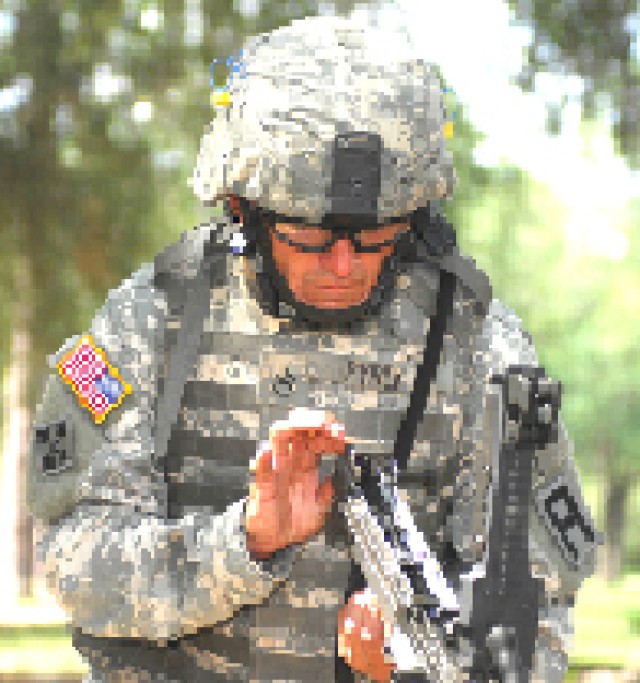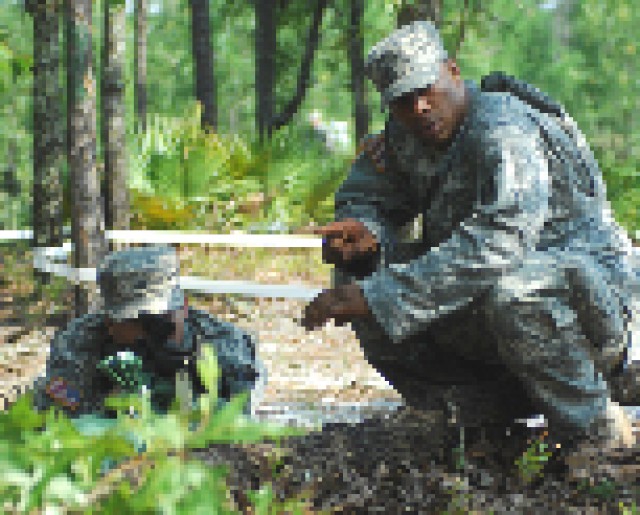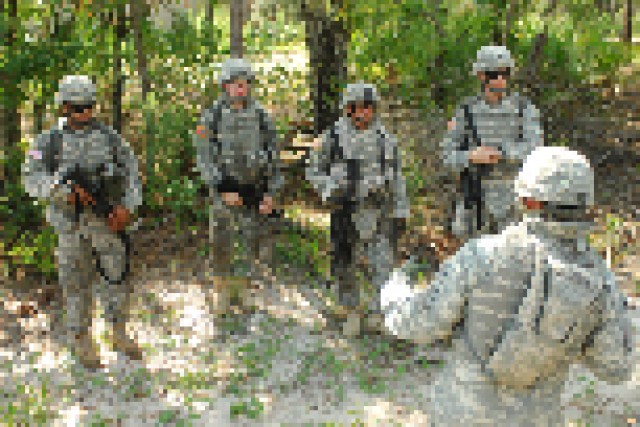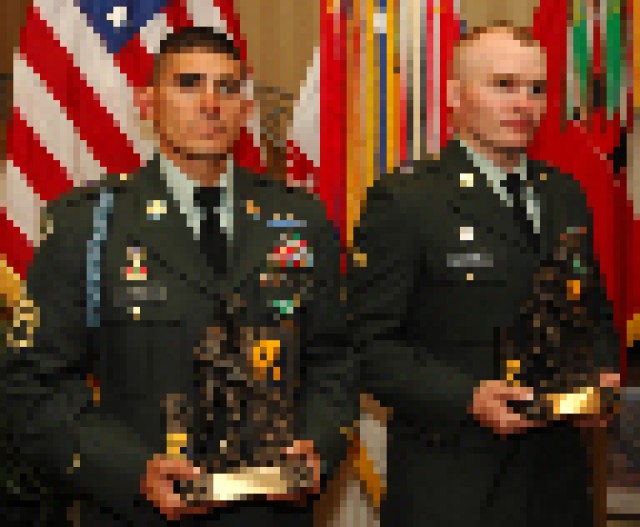Nestled among the moss-laden oaks and Kingsley Lake, just outside of Jacksonville, Fla., lies the perfect vacation spot to relax, unwind, and refresh.
For four First Army Soldiers, however, it was anything but a vacation.
Instead, this area was the chosen site for this year's First Army Noncommissioned Officer and Soldier of the Year competition. Despite the proximity of the lake, these Soldiers' paths crossed only the most intense training sites and ranges while battling the sweltering heat and humidity.
The process for these four Soldiers began in January and February, as Soldiers at First Army's 103 training battalions began their journey towards seeking the title of First Army's top NCO and Soldier for 2009.
Since First Army is comprised of active-duty, National Guard and Army Reserve Soldiers, this is one of only two commands eligible to send members representing each component through as competitors.
The grueling matches narrowed the field, starting at the battalion level and onward to the brigade and division level, eventually identifying the Division East and West NCO and Soldier of the Year.
The "old man" of the group was 40-year-old Staff Sgt. Gregory S. Pyrek, an observer-controller/trainer with the 5th Armored Brigade, Fort Bliss, Texas. Pyrek is from Castle Rock, Colo., and has been with the brigade for three years.
He served 14 years on active duty, having last been assigned as an infantryman with the 4th Infantry Division. Pyrek decided to continue with his military service as a mobilized Army reservist. He attended this event as the Division West NCO of the Year.
Another OC/T assigned to the 177th Armored Brigade, Camp Shelby, Miss., is Sgt. 1st Class John Lewis. The 33-year-old, Woodworth, La., native is an active duty field artilleryman who has been at the brigade for eight months. Lewis took part as the Division East NCO of the Year.
Spec. Kevin S. Jarvis, 22, is an Army Reserve Soldier with the 3-383rd Battalion, 166th Aviation Brigade, at Jefferson Barracks, St. Louis, Mo. Jarvis is a 68W-Medic from Granite City, Ill., and has been in the Army for two years. He competed as the Division West Soldier of the Year.
The newest competitor was Pfc. Lamar Gordon-Holmes, 23, who had 10 months of total service. The financial management technician is assigned to the 72nd Field Artillery Brigade, Fort Dix, N.J., and hails from Brooklyn, N.Y.
The 158th Infantry Brigade, First Army Division East, was tasked to conduct the competition with the mission guidance to train these Soldiers on individual tasks in a competitive manner, increase their proficiency and determine who would be the best NCO and Soldier to continue on as First Army representatives.
The four-day agenda consisted of 14 areas, each with a total point value. The NCO and Soldier who obtained the most points would proceed as the First Army representative in the next level.
Day One began with Soldier reception and in-processing, and ended with two tests - one covering map reading skills - and another on general military subjects, such as drill and ceremony, leadership, and Soldier knowledge.
Day Two tested motivation, physical and mental determination, skill, strength, knowledge, courage, competence and character.
The day started at 5:00 a.m. with an Army Physical Fitness Test. Contestants wore reflective clothing and belts around the quarter-mile track, and lighting systems were set up every 200 meters.
Following a five minute shower and a Meal-Ready-to-Eat breakfast while on the road to the range, the Soldiers then had to zero their assigned M4 rifles and put 40 rounds on target. Afterward, they moved to the M249 Squad Automatic Weapon, having to zero and qualify on that weapon.
Toward noon, the Soldiers faced an urban combat scenario at the Urban Defense Building, known as "The House of Horrors." Among the distractions of blaring music, smoke, and sounds of small arms fire, competitors needed to identify and treat role players splattered with blood and shredded clothing.
After completing the course, the Soldiers headed to Training Area S3 for the Day Land Navigation course. Receiving a Defense Advanced GPS Receiver, a lensatic compass, a map, and a protractor, competitors had to locate and correctly identify at least three of five navigation points in three hours. The NCOs headed out first and the Soldiers moved out 30 minutes later.
Next, each Soldiers' Army Warrior Task skills were tested. This portion of the competition required memory recall for procedure and sequence of steps for each task. If just one step was out of sequence, the task was scored a no-go.
After the skill test, the Soldiers confronted a test of strength, speed and agility on the timed obstacle course. These obstacles included climbing, weaving, sliding, jumping, crawling and swinging stations designed to push the limits of the Soldiers' upper and lower body strength.
With the obstacle course behind them, the participants moved on to the Combat Stress Shoot. Soldiers donned their battle-rattle and moved at their fastest and safest pace down the 400-meter course. They had to stop, lock and load a five-round magazine, then fire at a very large known-distance target.
As night fell, the Soldiers prepared for a night land navigation course and a 10km road march to finish the second day's gauntlet. By the end of the road march, the Soldiers had been on the move for more than 24 continuous hours.
Day three began with a combatives match that pitted NCO against NCO and Soldier against Soldier. The NCO match lasted one three-minute round, before one of the NCOs tapped out. The junior enlisted match lasted nearly the full three rounds until one Soldier's choke-hold was effective enough to force a tap-out.
The last of the outdoor events was the Weapons Proficiency Test. On-line were six different weapons used by Soldiers - the 9mm pistol, M4 Rifle, M240B Medium Machine Gun, M249 SAW, the MK19 Grenade Machine Gun and the M2 .50 Caliber Machine Gun. The competitors had to maintain and perform a functions check (disassemble and reassemble) on each weapon within the time allotted.
Following the weapons proficiency test, Command Sgt. Maj. Ronald Riling, First Army command sergeant major, praised the competitors. "Each and every one of you are winners," Riling said to the group, ".... because you stuck with it all the way to the three-star level. I'm proud of each of you."
Day Four consisted of the appearance board in a Class-A uniform. During this event, each Soldier reported to Command Sgt. Maj. Riling, and six other subordinate division and brigade command sergeants major. Each NCO and Soldier had to answer questions which tested their knowledge and ability to think and respond quickly and accurately.
After the board, the contestants, their sponsors, and those in attendance waited for the winners to be announced during the subsequent awards luncheon.
Winning this phase of the competition, and going on to represent First Army were Staff Sgt. Pyrek, as the NCO of the Year, and Spec. Jarvis as the Soldier of the Year.
Pyrek said he went into this competition with the mind-set that as an NCO he should be leading from the front and setting the example.
"I wanted to show Soldiers what it means to lead from the front and to be the best that I could possibly be. I feel that my combat experience helped me get through this experience, but most of all, being out here with fellow Soldiers and seeing their motivation helped me through."
Pyrek added, "I was the underdog in my unit," said Jarvis. "I wanted to prove to other Soldiers in my unit that I could do it. I was the newest member and I didn't have any active duty experience to call upon. But now, this has opened my eyes and it has shown me what I am really capable of doing."








Social Sharing